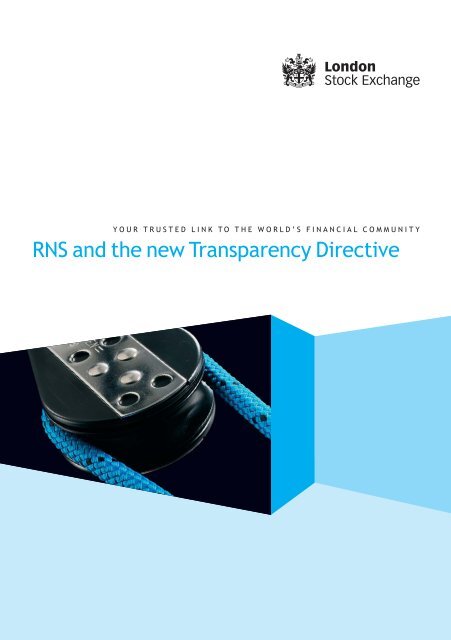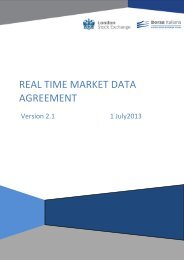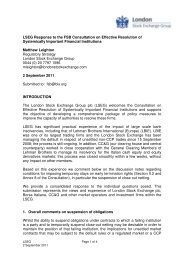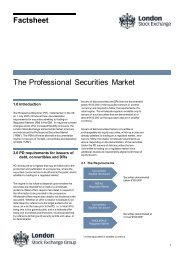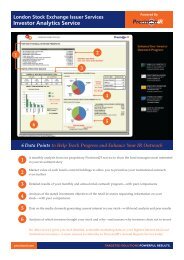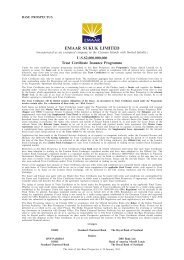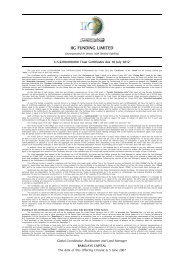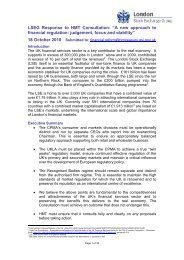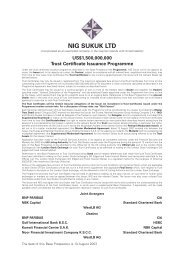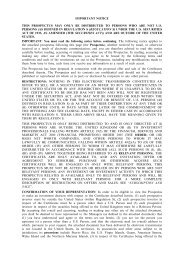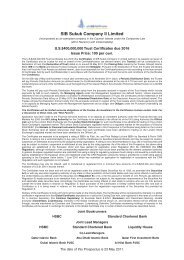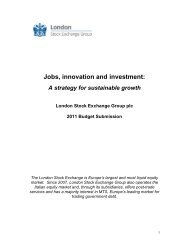RNS and the new Transparency Directive - London Stock Exchange
RNS and the new Transparency Directive - London Stock Exchange
RNS and the new Transparency Directive - London Stock Exchange
- No tags were found...
You also want an ePaper? Increase the reach of your titles
YUMPU automatically turns print PDFs into web optimized ePapers that Google loves.
YOUR TRUSTED LINK TO THE WORLD’S FINANCIAL COMMUNITY<strong>RNS</strong> <strong>and</strong> <strong>the</strong> <strong>new</strong> <strong>Transparency</strong> <strong>Directive</strong>
ContentsSection1 Pulling toge<strong>the</strong>r: The <strong>Transparency</strong> <strong>Directive</strong> overview2 Strength in numbers: How to disseminateinformation effectively3 Clarity <strong>and</strong> transparency: What <strong>the</strong> <strong>Transparency</strong><strong>Directive</strong> means for you4 The missing link: Looking to <strong>the</strong> future5 Glossary: Key terms explained
Introduction• The <strong>Transparency</strong> <strong>Directive</strong> takes effect in <strong>the</strong> UKfrom 20 January 2007.• This guide from <strong>RNS</strong> is intended to help companies<strong>and</strong> <strong>the</strong>ir advisers underst<strong>and</strong> more about <strong>the</strong><strong>Directive</strong> <strong>and</strong> its impact on <strong>the</strong>m.• We explain what <strong>the</strong> <strong>Transparency</strong> <strong>Directive</strong> is <strong>and</strong><strong>the</strong> inspiration behind it.• We describe how <strong>the</strong> <strong>Directive</strong> will be applied in <strong>the</strong> UK<strong>and</strong> we explain <strong>the</strong> part <strong>RNS</strong> has played – <strong>and</strong> will play– in its implementation.• We also explain <strong>the</strong> way in which <strong>the</strong> <strong>Transparency</strong><strong>Directive</strong> dovetails with o<strong>the</strong>r EU <strong>Directive</strong>s, all ofwhich are intended to make European capital marketswork more seamlessly <strong>and</strong> effectively.
“The test for <strong>the</strong> <strong>Directive</strong> is how far it succeeds in raisingst<strong>and</strong>ards of company reporting in jurisdictions where <strong>the</strong>y havenot been very high, without damaging practice in jurisdictionswith higher st<strong>and</strong>ards, such as <strong>the</strong> UK. I think we can berelatively optimistic on both counts”Peter Montagnon, Director of Investment Affairs, Association of British Insurers1 Pulling toge<strong>the</strong>r:The <strong>Transparency</strong> <strong>Directive</strong> overview1.1 The <strong>Transparency</strong> <strong>Directive</strong> overviewThe <strong>Transparency</strong> <strong>Directive</strong> will create a frameworkfor companies across Europe to adopt similarst<strong>and</strong>ards around information disclosure.The <strong>Directive</strong> has evolved over several years <strong>and</strong>has been influenced by consultation with a numberof interested parties, both in <strong>the</strong> UK <strong>and</strong> overseas.The impact of <strong>the</strong> <strong>Directive</strong> will be greater injurisdictions where <strong>the</strong>re is a less well developeddisclosure regime, so <strong>the</strong> impact for UK companieswill be limited.The <strong>Directive</strong> requires companies to discloseinformation at regular intervals through specificchannels <strong>and</strong>, in that way, it bears many similaritiesto <strong>the</strong> existing UK regime. But <strong>the</strong>re are certainareas in which <strong>the</strong> <strong>Directive</strong> will place <strong>new</strong> dem<strong>and</strong>son companies <strong>and</strong> <strong>the</strong>ir directors, particularly withrespect to forward-looking statements.Generally speaking, <strong>the</strong> <strong>Transparency</strong> <strong>Directive</strong>will not apply to AIM companies; however, <strong>the</strong>requirements concerning disclosure of voting rightswill apply to UK AIM companies. This requirementis explained in more detail later in Chapter 3.1.2 The rationaleThe brainchild of <strong>the</strong> European Commission,<strong>the</strong> <strong>Transparency</strong> <strong>Directive</strong> is part of a broaderproject – <strong>the</strong> Financial Services Action Plan (FSAP) –designed to create a single European capital market.The <strong>Transparency</strong> <strong>Directive</strong> works alongside o<strong>the</strong>rpieces of FSAP legislation, in particular <strong>the</strong> MarketAbuse <strong>Directive</strong> (MAD).Both cover disclosure but while <strong>the</strong> MAD focuseson <strong>the</strong> need to disseminate inside information assoon as possible in order to avoid market abuse,<strong>the</strong> <strong>Transparency</strong> <strong>Directive</strong> focuses on <strong>the</strong>information that needs to be disclosed on a periodicbasis, as well as shareholder disclosures <strong>and</strong> <strong>the</strong> wayin which disclosure should take place.Until now, each country in Europe has operatedindependently, imposing its own legislation <strong>and</strong>guidelines on companies <strong>and</strong> investors. Somecountries have been more lax than o<strong>the</strong>rs, both interms of <strong>the</strong> amount of information to be disclosedby companies <strong>and</strong> <strong>the</strong> amount of informationdisclosed by investors.This unlevel playing field has disadvantagedcompanies <strong>and</strong> shareholders. And in recent years,<strong>the</strong> need for a harmonised European capital markethas intensified, reflecting a growing desire amongglobal investors for dynamic disclosure – that is,immediate disclosure when <strong>the</strong>re is somethingimportant to say.In most instances, <strong>the</strong> UK is already <strong>the</strong>re. Much of<strong>the</strong> content within <strong>the</strong> <strong>Transparency</strong> <strong>Directive</strong> hasbeen based on <strong>London</strong> best practice <strong>and</strong> regulators<strong>and</strong> interested parties in <strong>London</strong>, including <strong>RNS</strong>,have been widely consulted.1.3 The benefitsThe <strong>Transparency</strong> <strong>Directive</strong> should benefit companies<strong>and</strong> investors. In <strong>the</strong> past, investors have found ithard to compare information on companies fromdifferent countries in Europe <strong>and</strong> this has, at times,made <strong>the</strong>m more cautious about investing. Greatertransparency will make comparative analysis easierfor investors <strong>and</strong> this is expected to boost shareholderconfidence. The cost of capital should also bereduced, for at least some companies, as investorsshow <strong>the</strong>ir preference for corporate transparency.
1.4 The key pointsIn essence, <strong>the</strong> <strong>Transparency</strong> <strong>Directive</strong> covers <strong>the</strong>content <strong>and</strong> regularity with which companies shouldreport financial information <strong>and</strong> <strong>the</strong> way in whichthat information should be relayed to <strong>the</strong> market.The <strong>Directive</strong> also obliges investors to disclosekey shareholdings:• For companies, <strong>the</strong> <strong>Directive</strong> requires <strong>the</strong>m toproduce annual <strong>and</strong> half-yearly (formerly interim)financial reports. In addition, <strong>the</strong> <strong>Directive</strong> obligescompanies to produce an “interim managementstatement” for <strong>the</strong> first <strong>and</strong> third quarters of <strong>the</strong>irfinancial year. This is a <strong>new</strong> requirement forcompanies that do not already report quarterly<strong>and</strong> <strong>the</strong> specific nature of <strong>the</strong>se statements isan ongoing topic for debate between companies<strong>and</strong> regulatory authorities.• Companies are also obliged to disclose regulatedinformation 1 on a fast <strong>and</strong> pan-European basis.For UK-listed companies, this is, broadly-speaking,business as usual. They already use RegulatoryInformation Services, such as <strong>RNS</strong>, to disseminateinformation widely <strong>and</strong> speedily. In Europe, however,different methods have predominated – such asdissemination via print media or company websites.• The <strong>Transparency</strong> <strong>Directive</strong> places dem<strong>and</strong>son investors too as <strong>the</strong>y are obliged to notifycompanies once <strong>the</strong>y have built up certainshare stakes.• Finally, <strong>the</strong> <strong>Directive</strong> requires member statesto ensure <strong>the</strong>re is at least one Officially AppointedMechanism (OAM) for <strong>the</strong> central storage ofregulated information. The precise nature of<strong>the</strong>se OAMs is subject to continuing discussion<strong>and</strong> will involve a fur<strong>the</strong>r phase of consultation<strong>and</strong> implementation.1.5 The <strong>Transparency</strong> <strong>Directive</strong> in <strong>the</strong> UKIn all four areas listed above, <strong>the</strong> <strong>Transparency</strong><strong>Directive</strong> has been informed by <strong>the</strong> UK model <strong>and</strong>recognition has been given that this model works,<strong>and</strong> works well.The legislation is, however, a “minimumharmonisation directive”, which means thatEU member states, such as <strong>the</strong> UK, can imposeadditional requirements (known as superequivalence)on companies <strong>and</strong> investors.In <strong>the</strong> UK, <strong>the</strong> Financial Services Authority (FSA) istasked with implementing <strong>the</strong> <strong>Transparency</strong> <strong>Directive</strong>but it has sought <strong>the</strong> views of various representativebodies <strong>and</strong> interested parties, including <strong>the</strong> <strong>London</strong><strong>Stock</strong> <strong>Exchange</strong>.While some aspects of implementation are yet tobe finalised <strong>and</strong> best practice interpretation willevolve, <strong>the</strong> <strong>Directive</strong> will become a fact of Europeancompany life in early 2007. The final rules 2 for initialimplementation (excluding OAMs) were publishedin October 2006 <strong>and</strong> markets will be expected toimplement <strong>the</strong> <strong>Directive</strong> from 20 January 2007.1Regulated information is all <strong>the</strong> information that is required to be disclosedunder <strong>the</strong> <strong>Transparency</strong> <strong>Directive</strong>, inside information <strong>and</strong> any o<strong>the</strong>rinformation requirements required in <strong>the</strong> home member state.2Subject to European Commission finalisation of implementation measures<strong>and</strong> Royal Assent to <strong>the</strong> UK Companies Bill.
2 Strength in numbers:How to disseminate information effectively2.1 <strong>RNS</strong> is <strong>the</strong> leading service provider for disclosureof regulated information in <strong>the</strong> UK market:• eight out of ten UK companies use <strong>RNS</strong>• nine out of ten UK companies use <strong>RNS</strong> forprice-sensitive announcements• over 90% of <strong>the</strong> FTSE100 companies use <strong>RNS</strong>• <strong>RNS</strong> releases over 650 announcements a dayon average.Since 1990 <strong>RNS</strong> has been <strong>the</strong> foremost regulatory<strong>new</strong>s distribution service in <strong>the</strong> UK <strong>and</strong> worksalongside o<strong>the</strong>r leading financial <strong>new</strong>s distributorsacross <strong>the</strong> world.With more expertise in distributing regulatoryannouncements than any o<strong>the</strong>r organisation, <strong>RNS</strong>allows issuers to have confidence <strong>the</strong>ir informationwill be disseminated efficiently, securely <strong>and</strong> inaccordance with local regulatory regimes.<strong>RNS</strong> distribution channels use <strong>the</strong> <strong>London</strong> <strong>Stock</strong><strong>Exchange</strong>’s trading infrastructure, which is knownfor its performance <strong>and</strong> resilience. Our clientsare assured <strong>the</strong>ir needs are met even whenunder pressure.2.2 <strong>RNS</strong> <strong>and</strong> <strong>the</strong> <strong>Transparency</strong> <strong>Directive</strong><strong>RNS</strong> already meets <strong>the</strong> requirements of <strong>the</strong><strong>Transparency</strong> <strong>Directive</strong> in that it achieves pan-European <strong>and</strong> global disclosure.This means <strong>RNS</strong> customers can continue todisseminate information in exactly <strong>the</strong> same way as<strong>the</strong>y have traditionally done, once <strong>the</strong> <strong>Transparency</strong><strong>Directive</strong> takes effect.<strong>RNS</strong> meets <strong>the</strong> Financial Services Authority’s(FSA) requirements for UK dissemination, whichauthorises Primary Information Providers (including<strong>RNS</strong>) to act as Regulatory Information Services.The FSA will retain this system after implementationof <strong>the</strong> <strong>Transparency</strong> <strong>Directive</strong>.Strict guidelines apply to <strong>the</strong>se authorised providersof information so users of <strong>RNS</strong> can feel comfortableabout submitting regulated information <strong>and</strong> can besure that announcements will be h<strong>and</strong>led speedily,efficiently <strong>and</strong> securely. However, <strong>RNS</strong> sees <strong>the</strong>seas minimum st<strong>and</strong>ards <strong>and</strong> makes sure its service<strong>and</strong> performance levels exceed what is required in<strong>the</strong> FSA’s approval criteria.Customers appreciate, for example, <strong>the</strong> extendedsupport hours offered by <strong>RNS</strong> <strong>and</strong> <strong>the</strong> wide-rangingtechnical <strong>and</strong> regulatory knowledge of its supportteams. A recent survey revealed, in fact, that almost100% of queries are swiftly answered to customers’satisfaction.2.3 Pan-European disclosureThe <strong>Transparency</strong> <strong>Directive</strong> requires companiesto disseminate information on a pan-Europeanbasis providing rapid disclosure <strong>and</strong> equality ofaccess to investors. <strong>RNS</strong> satisfies this requirementby distributing information to electronic financialmedia firms such as Reuters, Bloomberg,Dow Jones <strong>and</strong> AFX.These media services disseminate <strong>the</strong> full text ofall regulated information <strong>and</strong> information is availablevia financial websites too so it can be easily accessedby hundreds of thous<strong>and</strong>s of retail investors,investment professionals <strong>and</strong> global stakeholders.News disseminated by <strong>RNS</strong> is highly regarded <strong>and</strong>trusted worldwide, helping <strong>RNS</strong>’s clients’announcements gain maximum exposure.
“I think <strong>the</strong> <strong>RNS</strong> team is fantastic. They have gone above <strong>and</strong>beyond <strong>the</strong> call of duty when it comes to submitting our verytechnically challenging 23-page earnings press release”IR Project Co-ordinator, Sony Corporation<strong>RNS</strong> process flow diagramCompany submitsannouncementUsing <strong>RNS</strong>’s intuitivesubmission tools• Security• Formatting• Reliability• Customer service• Market efficiencyAnnouncementdistributed through<strong>the</strong> <strong>Exchange</strong>’strading <strong>and</strong>information networkElectronicFinancial MediaIncluding:• Bloomberg• Thomson Reuters• AFX• ProquoteAnnouncement filed with FSA(Via AFX)Market professional servicesOver 750,000 dealer terminalswithin financial institutions worldwideFinancial websites/Online mediaInternationalregulatory filings(eg, EDGAR) <strong>and</strong>media distributionIncluding:www.advfn.comwww.bloomberg.comwww.investegate.co.ukwww.londonstockexchange.comwww.reuters.comNewswires <strong>and</strong> IR providersIncluding:AFXDow JonesFactsetHemscottInvestisFinancial databasesIncluding:FactivaLexis-NexisPerfect information
3 Clarity <strong>and</strong> transparency:What <strong>the</strong> <strong>Transparency</strong> <strong>Directive</strong> means for youThis section of our guide addresses <strong>the</strong> most commonlyasked questions about <strong>the</strong> <strong>Transparency</strong> <strong>Directive</strong> <strong>and</strong>related EU <strong>Directive</strong>s.3.1 What are <strong>the</strong> main differences between <strong>the</strong><strong>Transparency</strong> <strong>Directive</strong> <strong>and</strong> existing UKrequirements?There are three key differences:• First, all companies will be required to publishfinancial statements four times a year – an annualreport, a half-yearly report <strong>and</strong> two interimmanagement statements or quarterly reports.• Second, <strong>the</strong> half-yearly report will need to include<strong>the</strong> principal risks <strong>and</strong> uncertainties to a company’sbusiness for <strong>the</strong> remaining six months of <strong>the</strong> year.• Third, <strong>the</strong> annual report will need to be publishedwithin four months of <strong>the</strong> year-end ra<strong>the</strong>r than sixmonths. Companies will no longer be obliged topublish a preliminary statement of annual results,although <strong>the</strong>y can still do so.3.2 What will companies have to include in <strong>the</strong>annual report?The annual report will have to include auditedfinancial statements, a management report <strong>and</strong>responsibility statements. The management reportmust include a fair review of <strong>the</strong> business <strong>and</strong> adescription of <strong>the</strong> principal risks <strong>and</strong> uncertaintiesof <strong>the</strong> business going forward. Among <strong>the</strong>requirements on content, <strong>the</strong> review must includekey performance indicators, financial <strong>and</strong> nonfinancial.Environmental <strong>and</strong> human capital KPIs must<strong>the</strong>refore be included. These requirements are notbroadly different from those already applicable tomost UK-incorporated companies.3.3 What will companies have to include in <strong>the</strong> halfyearlyreport?The half-yearly report (previously referred to as“interim results”) will have to include a condensedset of financial statements as currently required forUK-listed companies, a management report <strong>and</strong>responsibility statements. Among <strong>the</strong> requirements,<strong>the</strong> report will also have to include, for <strong>the</strong> first time,a statement of <strong>the</strong> principal risks <strong>and</strong> uncertaintiesthat may affect <strong>the</strong> business over <strong>the</strong> followingsix months.3.4 What are interim management statements <strong>and</strong> whatwill companies have to include in <strong>the</strong>m?Interim management statements are publishedreports that will be issued between <strong>the</strong> annual report<strong>and</strong> <strong>the</strong> half-yearly report <strong>and</strong> again between <strong>the</strong> halfyearlyreport <strong>and</strong> <strong>the</strong> annual report. The <strong>Transparency</strong><strong>Directive</strong> has deliberately refrained from calling <strong>the</strong>mquarterly reports because <strong>the</strong>y are intended to bequalitatively different from US quarterly earningsstatements.Interim management statements will give a generaldescription of a company’s financial position <strong>and</strong>performance <strong>and</strong> describe any material events ortransactions that have taken place during <strong>the</strong>reporting period. They will be more detailed thanUK-style trading statements but less prescriptivethan US quarterly earnings reports. The FinancialServices Authority (FSA) will provide guidance onwhat does not need to be included in interimmanagement statements. This will be published ina special edition of List! <strong>the</strong> <strong>new</strong>sletter from <strong>the</strong> UKListing Authority. The FSA has introduced a <strong>new</strong>announcement headline for <strong>the</strong>se disclosures,“Interim management statements.” Thosecompanies that already publish quarterly reports maycontinue doing so <strong>and</strong> will not have to publish interimmanagement statements as well.
3.4 Will preliminary statements still be necessary?Most companies will probably continue to issuepreliminary statements, even though <strong>the</strong><strong>Transparency</strong> <strong>Directive</strong> does not oblige <strong>the</strong>m to doso. First, investors are very much in favour of <strong>the</strong>m.Second, companies are used to publishing <strong>the</strong>m <strong>and</strong><strong>the</strong>ir systems are geared up to do so. Third, if <strong>the</strong>yare preparing <strong>the</strong>ir annual results <strong>and</strong> discover amaterial piece of information, <strong>the</strong>y will have to makean announcement without delay. Companies that dochoose to publish preliminary statements will berequired to meet <strong>the</strong> existing content st<strong>and</strong>ards.3.5 Should companies be worried about increasedliability?The <strong>Transparency</strong> <strong>Directive</strong> requires companies tomake more forward-looking statements than before<strong>and</strong> to make reports public throughout <strong>the</strong> EU(regardless of whe<strong>the</strong>r companies have shareholdersor a listing in every member state). There is someunderst<strong>and</strong>able concern about this but lawyerssuggest that, for UK companies, <strong>the</strong> normal highst<strong>and</strong>ards of care with which information is producedshould be sufficient to prevent <strong>the</strong>m from being suedby investors. The Companies Bill contains “safeharbour” provisions for <strong>Transparency</strong> <strong>Directive</strong>periodic reporting, effectively stating that directorsare only liable to investors if <strong>the</strong>y are being dishonestor reckless. There is discussion about extending thisto include preliminary statements of results.3.6 When will <strong>the</strong> changes take effect?The <strong>Transparency</strong> <strong>Directive</strong> will apply to financialyears that begin on or after 20 January 2007. Thismeans that companies whose year end is 31 Marchwill be required to publish <strong>the</strong>ir first interimmanagement statement in June to August 2007.Thereafter, <strong>the</strong>ir half-yearly <strong>and</strong> annual reports willhave to be <strong>Transparency</strong> <strong>Directive</strong>-compliant.Companies with a 31 December year-end will nothave to publish <strong>the</strong>ir first interim managementstatement until March to May 2008. And <strong>the</strong>ir first<strong>Transparency</strong> <strong>Directive</strong>-compliant annual report willnot be produced until 2009.3.7 How will <strong>the</strong> annual cycle work in practice?The <strong>Directive</strong> states that interim managementstatements must be made at least ten weeks after<strong>the</strong> start of each half-year <strong>and</strong> six weeks before <strong>the</strong>end of <strong>the</strong> period. Broadly speaking, this equatesto <strong>the</strong> first <strong>and</strong> third quarters of <strong>the</strong> financial year.Companies with a 31 December year-end, forexample, will publish <strong>the</strong>ir first interim managementstatement no earlier than mid-March <strong>and</strong> no later thanmid-May. Their second interim managementstatement will be published no earlier than <strong>the</strong> mid-September <strong>and</strong> no later than mid-November.3.8 How will <strong>the</strong> changes take effect?The <strong>Transparency</strong> <strong>Directive</strong> will be implemented in<strong>the</strong> UK by 20 January 2007. The FSA will incorporate<strong>the</strong> <strong>new</strong> transparency rules into its Disclosure RulesSourcebook <strong>and</strong> rename it <strong>the</strong> Disclosure <strong>and</strong><strong>Transparency</strong> Rules Sourcebook. If a company orcompany director breaches <strong>the</strong>se rules, <strong>the</strong>y canbe sanctioned or fined. Some parts of <strong>the</strong> <strong>Directive</strong>also require primary legislation <strong>and</strong> <strong>the</strong>se will beincorporated into <strong>the</strong> <strong>new</strong> Companies Act.
“The <strong>Transparency</strong> <strong>Directive</strong> is sometimes portrayed as <strong>the</strong> end of <strong>the</strong> known world.It isn’t by any means. For UK companies that are competitive, successful <strong>and</strong> havestrong prospects, making <strong>the</strong>se more transparent to a wider class of investors quicker<strong>and</strong> electronically is a good thing <strong>and</strong> a potential competitive advantage”Charles Mayo, Partner, Simmons & Simmons3 Clarity <strong>and</strong> transparency (cont.):What <strong>the</strong> <strong>Transparency</strong> <strong>Directive</strong> means for you3.9 How will companies disseminate <strong>the</strong> information<strong>the</strong>y are now required to disclose?The <strong>Directive</strong> requires Member States to ensureregulated information is disseminated throughoutEurope to ensure that investors have fast access ona non-discriminatory basis. Companies are ultimatelyresponsible for meeting this st<strong>and</strong>ard. In practice,UK companies will be able to comply with this bysending financial information to an RIS, such as <strong>RNS</strong>.The role of <strong>the</strong> RIS is to ensure that <strong>the</strong> informationis transmitted to media services like Reuters <strong>and</strong>Bloomberg rapidly <strong>and</strong> securely. There is no longera requirement for companies to publish half-yearlyreports in <strong>new</strong>spapers or send <strong>the</strong>m to every holderof <strong>the</strong>ir securities.3.10 How will information be filed?The <strong>Directive</strong> requires companies to file informationwith <strong>the</strong> competent authority of its home memberstate. In <strong>the</strong> UK, companies satisfy this requirementby using an RIS.3.11 What are <strong>the</strong> requirements for storage ofregulated information?Under <strong>the</strong> <strong>Transparency</strong> <strong>Directive</strong>, all regulatedinformation must be filed for five years after it hasbeen disseminated to provide a comprehensiveresource for investors. Ra<strong>the</strong>r than a centralisedrepository such as <strong>the</strong> SEC’s EDGAR system, adecentralised model is envisaged with one or moreOAM appointed in each member state. These will<strong>the</strong>n be networked across Europe. How this will workin practice is still being defined <strong>and</strong> will not be in placefor January 2007. As a transitional measure in <strong>the</strong>meantime, <strong>the</strong> FSA is enhancing <strong>the</strong> RIS section ofits website to provide more accessible links toinformation providers.3.12 Will <strong>the</strong> <strong>Transparency</strong> <strong>Directive</strong> impactinvestors too?The <strong>Directive</strong> will require investors to issue anotification when <strong>the</strong>y have reached, exceeded or fallenbelow 5%, 10%, 15%, 20%, 25%, 30%, 50% <strong>and</strong> 75%of <strong>the</strong> voting rights in a company. At present, investorsin UK companies typically have to issue a notificationwhen <strong>the</strong>y have built up a shareholding of 3% <strong>and</strong> at 1%intervals <strong>the</strong>reafter. The present thresholds willcontinue to be applied to both Main Market 1 <strong>and</strong> UKAIM companies. The FSA is requiring disclosure to bemade by using a st<strong>and</strong>ard form <strong>and</strong> is also retaining <strong>the</strong>current deadlines for notifications by investors tocompanies <strong>and</strong> by companies to an RIS. Therequirements for notification are triggered byreference to <strong>the</strong> percentage of voting rights held,ra<strong>the</strong>r than <strong>the</strong> percentage of <strong>the</strong> nominal value ofshare capital in which a shareholder is interested.3.13 Do companies need to disclose details ofvoting rights?To provide a reference point for major shareholdernotifications, companies must disclose details of <strong>the</strong>total number of voting rights in respect of each classof share which it has issued <strong>and</strong> admitted to trading.Companies must also distinguish <strong>the</strong> number ofvoting rights attached to any shares held in Treasury.3.14 When must companies disclose details of <strong>the</strong>irvoting rights?Companies must make this disclosure to <strong>the</strong> marketvia an RIS by 31 December 2006. Companies willalso have to disclose any change which occursbetween <strong>the</strong> date on which <strong>the</strong> disclosure is made<strong>and</strong> 20 January 2007. Any subsequent changes willneed to be disclosed on a monthly basis. The FSAhas introduced a <strong>new</strong> announcement headline typefor <strong>the</strong>se disclosures, “Total Voting Rights’”.1Companies incorporated outside <strong>the</strong> EU may use <strong>the</strong>ir home jurisdiction’sshareholder notification regime if it is equivalent to that required by <strong>the</strong><strong>Transparency</strong> <strong>Directive</strong>.
3.15 Will o<strong>the</strong>r <strong>Directive</strong>s, linked to <strong>the</strong> <strong>Transparency</strong><strong>Directive</strong>, have an impact on companies <strong>and</strong>investors?Ano<strong>the</strong>r key element of <strong>the</strong> FSAP is <strong>the</strong> MarketAbuse <strong>Directive</strong> (MAD). As its name suggests, thisincludes a series of preventative measures aimed atreducing <strong>the</strong> incidence of market abuse. Themeasures cover <strong>the</strong> way companies h<strong>and</strong>le <strong>and</strong>disclose inside information <strong>and</strong> it obliges companies<strong>and</strong> <strong>the</strong>ir advisers to maintain “insider lists”.3.16 What constitutes inside information?Inside information is information that is precise, notgenerally available <strong>and</strong> price sensitive. The rules onhow to identify inside information, when to discloseit <strong>and</strong> communication with third parties are set outin <strong>the</strong> FSA’s Disclosure <strong>and</strong> <strong>Transparency</strong> RulesSourcebook. Issue nine of List! provides fur<strong>the</strong>radvice on good practice with respect to insideinformation.3.17 What are <strong>the</strong> requirements for h<strong>and</strong>ling insideinformation?Companies need to have appropriate systems<strong>and</strong> controls in place to identify inside information<strong>and</strong> ensure its timely disclosure. Companies mustalso notify a RIS as soon as possible of any insideinformation that directly concerns <strong>the</strong>m, except inspecific circumstances where disclosure wouldprejudice <strong>the</strong>ir legitimate interests.3.19 What are PDMRs?PDMRs are defined as “Persons DischargingManagerial Responsibility”. In practice, this meansmain board directors, both executive <strong>and</strong> nonexecutive,as well as senior managers with <strong>the</strong>authority to make strategic decisions.3.20 What are Annual Information Updates?Annual Information Updates are a requirement of<strong>the</strong> Prospectus <strong>Directive</strong>, which also forms part of<strong>the</strong> Financial Services Action Plan. These updatesare a compilation of all <strong>the</strong> disclosures a companyhas made in <strong>the</strong> UK <strong>and</strong> abroad over <strong>the</strong> past12 months. Most companies comply with <strong>the</strong>requirement by publishing a digest of announcemen<strong>the</strong>adlines <strong>and</strong> <strong>the</strong> dates on which <strong>the</strong>y appeared.3.21 Does <strong>the</strong> <strong>Transparency</strong> <strong>Directive</strong> have an impacton AIM companies?Generally speaking, <strong>the</strong> <strong>Transparency</strong> <strong>Directive</strong> doesnot apply to AIM companies. But <strong>the</strong>y will need todisclose voting rights, alongside Main Marketcompanies, <strong>and</strong> AIM companies may be affected bysome parts of <strong>the</strong> <strong>new</strong> Companies Act. The MADalso applies to AIM companies, although certaindisclosure obligations (such as insider lists) do not.Generally speaking, <strong>the</strong> Prospectus <strong>Directive</strong> will notapply to AIM companies unless <strong>the</strong>y make an offer to<strong>the</strong> public which falls within scope.3.18 What are <strong>the</strong> requirements for publishing insideinformation on <strong>the</strong> company’s website?If companies announce any inside information via anRIS, <strong>the</strong>y must make that information available on<strong>the</strong>ir website by <strong>the</strong> close of <strong>the</strong> next business day.The information may not be published on <strong>the</strong> websitebefore it is announced via an RIS <strong>and</strong> it must beavailable on <strong>the</strong> website for at least a year.
4 The missing link:Looking to <strong>the</strong> futureAs this guide makes clear, <strong>the</strong> world of financial disclosureis evolving. At <strong>RNS</strong>, our aim is to help companies adapt to<strong>the</strong> <strong>new</strong> environment with minimum disruption.Over <strong>the</strong> past few years, customers will have already seenseveral significant changes to our service. Whereaspreviously our expertise lay in UK regulatory <strong>new</strong>sdistribution, we have now diversified to deliver a morecomprehensive suite of communication services to ourcustomers. We transmit information not only throughregulatory channels but also through <strong>the</strong> financial media –<strong>and</strong> we distribute not just in <strong>the</strong> UK but to jurisdictionsacross <strong>the</strong> globe.<strong>RNS</strong> ReachThis provides companies with an ideal platform todeliver important <strong>new</strong>s, such as product launches <strong>and</strong>contract wins to <strong>the</strong> key financial audience via <strong>the</strong> samedistribution channel.The Financial Services Action Plan (FSAP) <strong>and</strong> <strong>the</strong> adventof <strong>new</strong> interactive technologies will have a profound impacton <strong>the</strong> European disclosure l<strong>and</strong>scape. But <strong>the</strong> <strong>London</strong><strong>Stock</strong> <strong>Exchange</strong> <strong>and</strong> <strong>RNS</strong> are committed to staying at <strong>the</strong>forefront of <strong>new</strong> developments.We have already influenced <strong>the</strong> way in which <strong>the</strong> FSAP willbe implemented in <strong>the</strong> UK <strong>and</strong> we are also monitoringinteractive technology developments closely.Our systems will evolve so that we stay ahead of changeas it occurs. In fact, we have already started work on aproject to transform <strong>the</strong> <strong>RNS</strong> user interface <strong>and</strong> greatlyimprove <strong>the</strong> service we offer our customers.In <strong>the</strong> next few years, we expect developments, suchas interactive data, to gain momentum. This will nothappen overnight however <strong>and</strong> needs widespreadsupport for adoption. As <strong>the</strong>se developments take shapewe will make sure our customers are kept fully informed.Worldwide media distributionWe distribute announcements to key financial media <strong>and</strong>best-practice disclosure points in Europe <strong>and</strong> <strong>the</strong> US,including those recommended by <strong>the</strong> New York <strong>Stock</strong><strong>Exchange</strong> <strong>and</strong> NASDAQ.Worldwide regulatory distributionWe can distribute your announcements to fulfil German,Swiss <strong>and</strong> Austrian disclosure obligations in Europe, <strong>and</strong>we can file announcements in <strong>the</strong> US via <strong>the</strong> SEC’sEDGAR system. All disclosure is seamless through <strong>the</strong><strong>RNS</strong> user interface. And it is often much cheaper than ourcompetitors.FT Company Announcement ServiceThis <strong>new</strong> service allows companies to publish <strong>the</strong>irannouncements in <strong>the</strong> world’s leading business<strong>new</strong>spaper. <strong>RNS</strong> clients can do this through <strong>the</strong>client interface.
“We will continue to track <strong>and</strong> be involved with internationaldevelopments on <strong>the</strong> disclosure l<strong>and</strong>scape <strong>and</strong> we will adaptour systems in <strong>the</strong> most sympa<strong>the</strong>tic way for customers,communicating with <strong>the</strong>m on every step of <strong>the</strong> journey”Paul Rennison, Head of <strong>RNS</strong>
For fur<strong>the</strong>r informationIf you have any questions about <strong>the</strong> contents of thisguide, we would be happy to talk to you. Contact us on020 7797 4400 or rns@londonstockexchange.com
Glossary of termsProspectus <strong>Directive</strong>Sets out <strong>the</strong> initial disclosure obligations for issuersof securities that are offered to <strong>the</strong> public or admittedto trading on a regulated market in <strong>the</strong> EU. It enablescompanies to raise capital across <strong>the</strong> EU on <strong>the</strong> basisof a single prospectus.Regulated informationInformation that companies are required to discloseunder <strong>the</strong> <strong>Transparency</strong> <strong>Directive</strong>, Market Abuse<strong>Directive</strong> <strong>and</strong> Prospectus <strong>Directive</strong>. Includes periodicreporting, shareholder disclosures, inside information<strong>and</strong> any o<strong>the</strong>r information requirements made by <strong>the</strong>home Member State.Regulated Information Service (RIS)A Primary Information Provider that has been authorisedby <strong>the</strong> FSA.<strong>Transparency</strong> <strong>Directive</strong>Part of <strong>the</strong> FSAP <strong>and</strong> designed to establish minimumst<strong>and</strong>ards for periodic reporting, major shareholdingnotifications <strong>and</strong> <strong>the</strong> dissemination <strong>and</strong> storage ofregulated information.
Glossary of termsExtend this flap while reading through this guideif you wish.Annual Information UpdatesAnnual Information Updates (a requirement of <strong>the</strong>Prospectus <strong>Directive</strong>) need to contain or refer toall <strong>the</strong> information that has been published or madeavailable to <strong>the</strong> public over <strong>the</strong> preceding 12 months.Companies Act 2000This gave <strong>the</strong> Financial Services Authority (FSA) statutorypowers to become <strong>the</strong> regulator of <strong>the</strong> financial servicesindustry in <strong>the</strong> UK.Disclosure <strong>and</strong> <strong>Transparency</strong> Rules SourcebookProduced by <strong>the</strong> FSA, this will incorporate <strong>the</strong> <strong>new</strong><strong>Transparency</strong> <strong>Directive</strong> rules. Previously called<strong>the</strong> Disclosure Rules Sourcebook.Electronic data ga<strong>the</strong>ring, analysis <strong>and</strong>retrieval system (EDGAR)System set up by <strong>the</strong> US Securities <strong>and</strong> <strong>Exchange</strong>Commission for receiving <strong>and</strong> disseminatingcorporate filings electronically.The Financial Services Action Plan (FSAP)The EU initiative to improve <strong>the</strong> single market in financialservices. The <strong>Transparency</strong> <strong>Directive</strong> is part of <strong>the</strong> FSAP.Inside informationInformation that is precise, not generally available<strong>and</strong> price sensitive in accordance with <strong>the</strong>Market Abuse <strong>Directive</strong>.Insider listsCompanies are required to keep a list of everyone who hasaccess to insider information, including directors, o<strong>the</strong>remployees <strong>and</strong> external advisers.Interim management statementsPublished reports that will be issued by listed companiesbetween <strong>the</strong> annual report <strong>and</strong> <strong>the</strong> half-yearly report <strong>and</strong>again between <strong>the</strong> half-yearly report <strong>and</strong> <strong>the</strong> annual report.List!A <strong>new</strong>sletter from <strong>the</strong> UK Listing Authority, which providesinformation <strong>and</strong> guidance of interest to listed companies.It is available from <strong>the</strong> FSA’s website (www.fsa.gov.uk).The Market Abuse <strong>Directive</strong> (MAD)Part of <strong>the</strong> FSAP <strong>and</strong> aimed at reducing <strong>the</strong> incidence ofmarket abuse. It covers <strong>the</strong> way companies h<strong>and</strong>le <strong>and</strong>disclose inside information <strong>and</strong> obliges companies <strong>and</strong><strong>the</strong>ir advisers to maintain “insider lists”.Officially Appointed Mechanism (OAM)A mechanism for <strong>the</strong> central storage of regulatedinformation. Each EU member state is required to haveat least one of <strong>the</strong>se, appointed by <strong>the</strong> local regulator –in <strong>the</strong> UK’s case, <strong>the</strong> FSA.Persons Discharging Managerial Responsibility (PDMR)Relating to main board directors, both executive <strong>and</strong> nonexecutive,as well as senior managers with <strong>the</strong> authority tomake strategic decisions.Primary Information Provider (PIP)Corporate <strong>new</strong>s distribution services which may beapproved by <strong>the</strong> FSA to act as Regulatory InformationServices (RIS) for <strong>the</strong> distribution of regulatoryinformation on behalf of listed companies.
Copyright © May 2009 <strong>London</strong> <strong>Stock</strong> <strong>Exchange</strong> plc. Registered inEngl<strong>and</strong> <strong>and</strong> Wales No. 2075721.<strong>London</strong> <strong>Stock</strong> <strong>Exchange</strong> plc has used all reasonable efforts to ensurethat <strong>the</strong> information contained in this publication is correct at <strong>the</strong> time ofgoing to press, but shall not be liable for decisions made in reliance on it.<strong>London</strong> <strong>Stock</strong> <strong>Exchange</strong> <strong>and</strong> <strong>the</strong> coat of arms device are registered trademarks of <strong>London</strong> <strong>Stock</strong> <strong>Exchange</strong> plc.All o<strong>the</strong>r logos are trade marks of <strong>the</strong>ir respective owners.<strong>London</strong> <strong>Stock</strong> <strong>Exchange</strong>10 Paternoster Square<strong>London</strong> EC4M 7LSTelephone: +44 (0)20 7797 1000www.londonstockexchange.comCOR/IRS/COL/092


